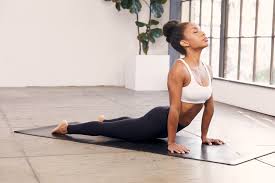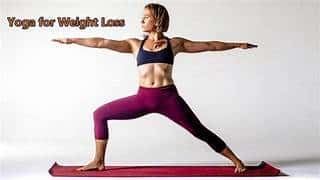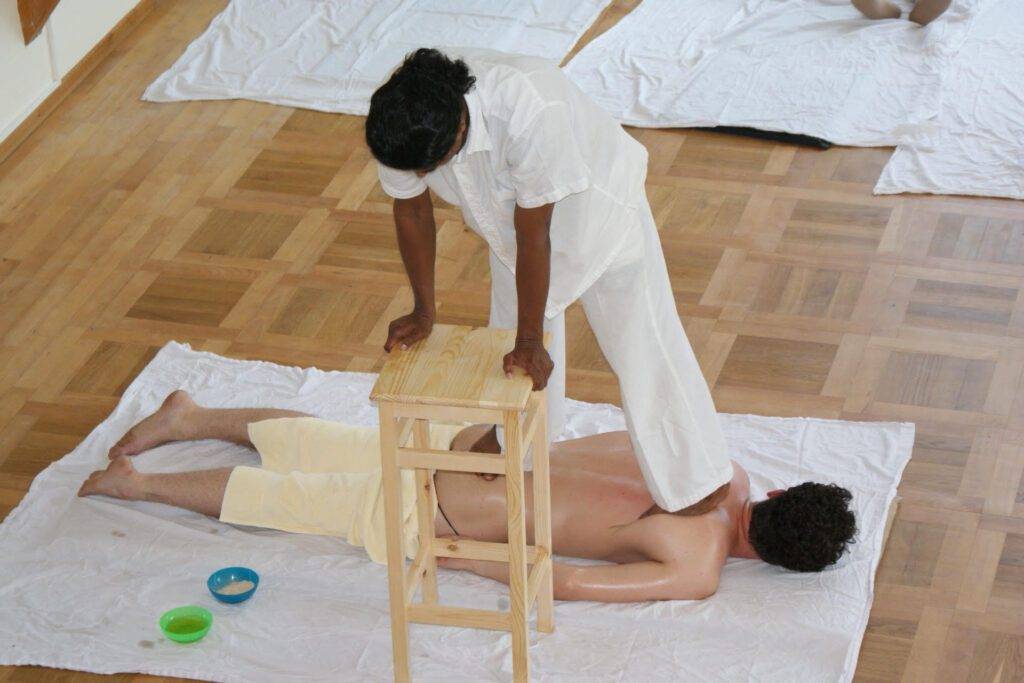An age-old discipline, yoga blends physical stances, breathing exercises, and meditation to improve flexibility, mental clarity, and general well-being. Starting many people on an ideal course is to join a yoga studio or take group classes. But with the appropriate knowledge and dedication, you may enjoy the rewards of yoga at home, making it an easy and practical choice for anyone wishing to improve their health.
Whether you are a total beginner or seeking to deepen your practice, this blog will show you how to perform yoga at home. From setting up a yoga area to the fundamental stances and methods to establish a mindful and sustainable practice, we’ll go over everything.

1. Setting Up Your Space
The first step in building a successful practice is creating a calm and practical area for yoga. A serene place where you can concentrate is necessary, even if you don’t require a large area or expensive equipment.
Choose the Right Location
Choose a location devoid of distractions—apart from the television, noise, or anything that could distract your attention. It could be in your bedroom, living room, or any nook where you feel peaceful and grounded.
- Clear the Area:
- Make sure the area is clean and neat. A tidy surroundings helps you remain focused during your practice and inspires relaxation.
- Create an Ambiance:
- For a relaxing impact, lower the lighting or use candles. To improve the ambiance, you may also play natural sounds or calming music. Many yoga practitioners feel that utilizing incense or essential oils can help them deepen relaxation and concentration.
- Use the Right Gear
- To provide comfort and stability, you must have a non-slip mat. It also safeguards your joints while posing.
- Optional props: Depending on the style of yoga, you might need blocks, belts, or blankets. These tools might enhance flexibility and let you change positions. For novices, however, they are not indispensable.
2. Start with the Basics: Breathing and Mindfulness
Before you start postures, it’s critical to learn the fundamentals of yoga: breath and awareness. Yoga is more about developing awareness of your body, mind, and breathing than about merely physical activity.
Breathwork (Pranayama):
- Often called “pranayama,” breath control is a crucial aspect of yoga. Breathing through the nose, Ujjayi breath produces a quiet sound at the back of the throat is the most used technique. This kind of breathing helps you keep focus and control your energy.
- A basic way to develop Ujjayi breathing is:
- Choose your position comfortably.
- Take a deep breath in through your nose, then make a quiet “ha” sound, similar to fogging up a mirror.
- Try to stretch both the inhalation and the exhalation to establish a consistent, soothing beat.
- Breathwork improves the physical advantages of every pose, lowers stress, and keeps you present throughout your workout.
3. Warm-Up: Gentle Movement to Prepare the Body
Warming up is essential for injury prevention and performance enhancement, just like in any other exercise. Your muscles, joints, and mind are ready for the more difficult postures coming when you properly warm up.
Some warm-up exercises to start your practice:
- Marjaryasana-Bitilasana, Cat-Cow Stretch, awakens your core and stretches your spine. Begin on your hands and knees, then alternate between arching your back (Cow posture) and rounding your spine (Cat pose).
- Starting in a tabletop position, raise your hips toward the ceiling to form an inverted V. This is known as downward dog (adho mukha svanasana). This opens your shoulders, calves, and hamstrings.
- Neck rolls and shoulder shrugs help relax the neck and shoulders, regions that are frequently strained by sitting or stress.
- Pay attention to your breath as you slowly and purposefully execute these warm-ups. To get your body ready for more profound stretches, start your practice with at least five to ten minutes of light movement.
4. Begin with Basic Poses
Sticking to basic positions is crucial for newcomers; as you get more at ease, you can advance to more difficult postures. Here’s a breakdown of some core beginner poses:
1. Mountain posture (Tadasana)
This is the starting point for several yoga poses; it is also an excellent way to increase body consciousness and posture.
- Hip-width apart or with your feet together.
- With your palms facing each other, engage your thighs, raise your chest, then stretch your arms overhead.
- Maintain your forward gaze and hold the posture for five to ten breaths.
2. Adho Mukha Svanasana, downward-facing dog
An iconic yoga posture that stresses the full body, especially the back, hamstrings, and arms.
- Begin in a tabletop posture.
- Form an upside-down V shape by raising your hips toward the roof.
- Keeping your head between your arms, press your hands forcefully into the mat and attempt to extend your legs.
3. Warrior I, or Virabhadrasana I
- This position expands the chest, stretches the hips, and strengthens the legs.
- From a standing posture, bend your front knee and step one foot backward.
- Open your chest and square forward, then reach your arms overhead.
- Wait for a few breaths, then rotate.
4. Tree Posture (Vrksasana)
- A balancing posture that boosts leg strength and clarity.
- Stand tall and then plant the sole of one foot on your inner calf or thigh (avoid the knee).
- Reach your arms upward or bring your palms near your chest.
- Hold for a few breaths, then rotate.
5. Child’s Pose
- This resting posture soothes the mind and gently elongates the back.
- Begin in a kneeling stance and sit back onto your heels.
- Drop your forehead toward the mat and extend your arms forward.
- Concentrate on deep relaxation and hold for several breaths.
Create a Routine for Yoga at Home: Consistency is Key

One of the most challenging aspects of practicing yoga at home is maintaining consistency. Creating a structured routine will help you stay motivated and build a sustainable practice.
Start Slow:
If you’re new to yoga at home, aim to practice 2-3 times a week for 20–30 minutes. As you progress, you can gradually increase the frequency and duration.
Plan Your Sessions:
Design your practice based on your energy levels and time. Here’s an example of a basic 30-minute session:
1. 5-10 minutes of warm-up: Start with gentle stretches and breathwork.
2. 15-20 minutes of postures: Focus on key poses like Downward Dog, Warrior I, Tree Pose, and Child’s Pose.
3. 5 minutes of cool-down: End with a seated position, focusing on deep breathing or a short meditation.
Track Your Progress:
Consider keeping a yoga journal to track your progress. Reflect on how you feel before and after each session, note any physical or emotional changes, and set goals for improvement.
Stay Mindful: The Power of Meditation
Yoga at home is not just about physical postures; it’s also a tool for mental clarity and mindfulness. Including a few minutes of meditation at the end of your practice can deepen the benefits.
Try a Simple Meditation:
- Sit comfortably with your spine straight, either on the floor or on a cushion.
- Close your eyes and take several deep breaths.
- Focus on the sensation of the breath entering and leaving your body.
- If your mind starts to wander, gently bring your attention back to your breath.
You can also experiment with guided meditation or mindfulness apps to enhance your practice.
Listen to Your Body
One of the most important aspects of practicing yoga at home is learning to listen to your body. Unlike a group class, where the instructor guides you, at home, you are your own teacher.
If you feel pain (rather than the usual stretching discomfort), ease off the pose. Don’t push yourself beyond your limits, as this can lead to injury. Over time, you’ll become more attuned to your body’s needs and abilities, helping you progress safely.
Resources for Home Practice
If you’re unsure about how to progress in your practice, there are plenty of online resources to support you:
- YouTube: Many yoga instructors offer free classes for beginners and advanced practitioners alike.
- Yoga Apps: Apps like Daily Yoga, Glo, and Yoga with Adriene provide a variety of classes for all levels.
- Books and Online Guides: Reading yoga books or following online blogs can offer valuable insights into different styles, techniques, and philosophies.
Final Thoughts: Yoga at Home Is a Journey, Not a Destination
Practicing yoga at home offers flexibility, convenience, and the opportunity to develop a deep, personal practice. Whether you’re looking to improve flexibility, relieve stress, or enhance overall health, yoga can help you achieve your goals. Start small, stay consistent, and enjoy the journey.
Remember, yoga is about more than just the poses—it’s a holistic practice that nurtures both body and mind. With patience and dedication, your home practice will evolve, and you’ll begin to notice the transformative effects on your life.





